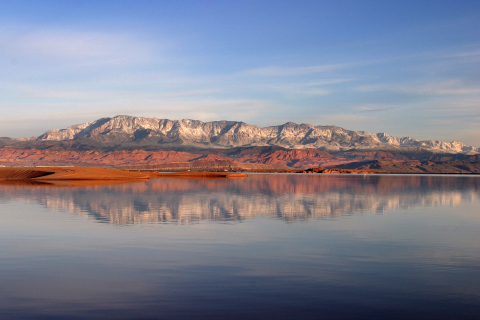Legislative Audit Reports District Can Repay the State of Utah for the Lake Powell Pipeline
The Washington County Water Conservancy District (district) can generate sufficient revenue to repay the Lake Powell Pipeline (LPP) costs, according to the Utah Office of the Legislative Auditor General report, “A Performance Audit of the Repayment Feasibility of the Lake Powell Pipeline” (audit) published today. The LPP is an estimated $1.1 to $1.8 billion project that will deliver water to 13 southern Utah communities.
This press release features multimedia. View the full release here: https://www.businesswire.com/news/home/20190820005769/en/

The Lake Powell Pipeline is a water infrastructure project that will bring water to 13 communities in southern Utah in a cost-effective, dependable and environmentally responsible way. When operating at full capacity, the LPP will deliver 86,249 acre feet of water annually from Lake Powell on the Colorado River to Sand Hollow Reservoir (shown here) through an underground pipeline to Washington and Kane counties. (Photo: Business Wire)
The audit was conducted in response to a legislative request to provide the state with an independent review of the financial viability of the project. Work on the audit started in late 2018.
The auditors considered the district’s anticipated revenue from impact fees, water rates and property taxes based on planned increases as well as the state’s projected growth estimates. Using this information, three hypothetical repayment structures were created and modeled to provide context on the district’s repayment ability:
- Payment structure 1: a straight-line payment over 50 years (equal payments made over 50 years)
- Payment structure 2: the district’s and Utah Division of Water Resources’ (DWRe) shared understanding of the financing terms specified in the Lake Powell Pipeline Development Act (act) that allows the district to repay for water gradually as it’s demanded
- Payment structure 3: same model as payment structure 2 with capitalized interest
The financing terms specified in the act are not based on straight-line payments nor does the act require the capitalization of interest; therefore, payment structure 2 is the only option that complies with statute.
In all hypothetical repayment structures, the district revenues exceeded the amount required to repay the state. The district’s current financing strategy, if fully executed, generates more than $6 billion in incremental revenue to pay for needed water infrastructure. However, the strategy will only be executed to the extent needed to meet the district’s actual financial obligations. The district will look at engineering and construction efficiencies to minimize borrowing costs and potential financial impacts to taxpayers.
The audit did report that, depending on the financing terms and growth, the first 10-15 years present the most challenge for repayment.
“That’s normal,” according to Utah Senate President J. Stuart Adams. “Infrastructure projects are sized to accommodate current and future residents, which is why the state’s repayment terms are structured to increase as the community grows.”
The district has already initiated several mechanisms to ensure the financial viability of the LPP including, but not limited to:
- Saving money for a project down payment, which is not required by statute;
- Enacting a general capital financing strategy that allows for the gradual increase of revenue (impact fees, water rates and property taxes) to generate additional funding;
- Creating a monthly surcharge on each water connection to offset potential revenue deficiencies from other funding sources; and
- Completing an independent third-party analysis on the district’s general capital financing strategy and resulting revenue capacity.
The results of the independent analysis, performed by Applied Analysis, also concluded that the district has sufficient revenue-generating capacity to repay the costs of the LPP. In addition, the analysis considered the economic impacts of the LPP on the community. “Washington County is expected to be among the fastest growing regions in the state of Utah and in the nation,” said Jeremy Aguero, principal analyst for Applied Analysis. “The economic impacts of southern Utah’s growth are significant for the region; they also provide for significant increases in revenue from the rates, fees and taxes used to pay for water infrastructure.”
Applied Analysis analyzed the economic and fiscal benefits to the state that would result from the LPP, including more than $20 billion in sales and income tax revenue, $9 billion in gross domestic product and more than 100,000 employment opportunities. “Having a safe, reliable water supply allows a community to prosper, while any real or perceived water shortage would likely stifle a community’s economy,” said Aguero.
Recommendations made in the audit include the preparation of a repayment plan for the LPP once the financing terms and costs are finalized, clarifying the terms for repayment and any expectation of a down payment, determining how repayment costs can be divided among and within repayment contracts, identifying the final repayment timeframe for outstanding reimbursable project costs and considering multiple funding sources. The district agrees with the recommendations, as noted in its response to the audit.
The LPP is an approximately 140-mile pipeline that will diversify and enhance water resources for Utah’s fastest growing and driest region by using a small portion of the state’s available Colorado River water right. Visit LPPUtah.org for more information.
About the Washington County Water Conservancy District
The Washington County Water Conservancy District is a not-for-profit public agency established in 1962 to manage Southern Utah’s regional water needs. The district oversees the development, stabilization, management, acquisition and conservation of water resources in Washington County in an ongoing effort to provide a safe, reliable water supply for current and future generations. Visit wcwcd.org for more information.
View source version on businesswire.com: https://www.businesswire.com/news/home/20190820005769/en/


